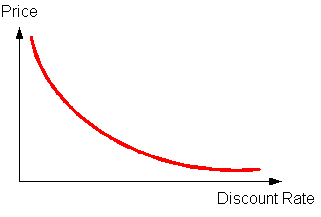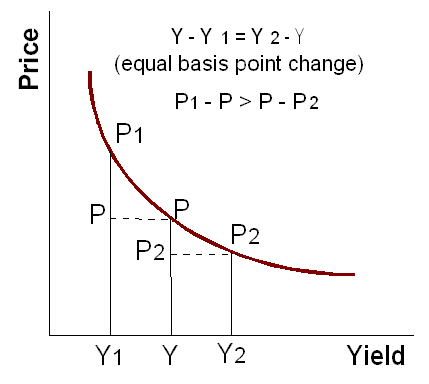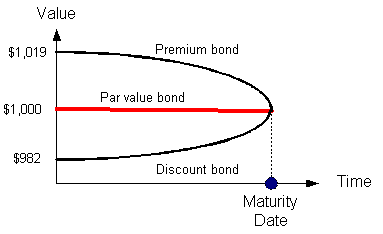Do you want BuboFlash to help you learning these things? Or do you want to add or correct something? Click here to log in or create user.
Subject 2. Relationships between Bond Price and Bond Characteristics
#basic-concepts #cfa #cfa-level-1 #fixed-income #has-images #reading-54-introduction-to-fixed-income-valuation
Price / Discount Rate Relationship




The value of a bond is equal to the present value of its coupon payments plus the present value of the maturity value.

The higher the discount rate, the lower a cash flow's present value and therefore since the value of a security is the present value of the cash flows, the higher the discount rate, the lower a security's value.
Example
A 1-year, semi-annual-pay bond has a $1,000 face value and a 10% coupon.
- At a discount rate of 8%, the bond value is $1,019 (premium).
- At a discount rate of 10%, the bond value is $1,000 (par).
- At a discount rate of 12%, the bond value is $982 (discount).
The degree of price change is not always the same for a particular bond. The price/yield relationship for an option-free bond is convex. In other words, this is not a straight-line relationship.

For a given change in yield, the price increases by more than it decreases. P1 - P > P - P2.
Option-free bonds exhibit positive convexity, which means that for a large change in interest rates, the amount of price appreciation is greater than the amount of price depreciation. This also means that the price change is greater when the level of required yield is low (and vice versa).
Coupon and Maturity Effects
All else being equal,
- Maturity effect: The longer the term to maturity, the greater the price volatility.
- Coupon effect: The lower the coupon rate, the greater the price volatility.
Constant-Yield Price Trajectory
As a bond moves closer to its maturity date, its value changes. More specifically, assuming that the discount rate does not change, a bond's value:
- decreases over time if the bond is selling at a premium
- increases over time if the bond is selling at a discount
- is unchanged if the bond is selling at par value
At the maturity date, the bond's value is equal to its par value ("pull to par value").

Pricing Bonds with Spot Rates
The valuation approach illustrated so far is the traditional approach, which uses a single interest rate to discount all of a bond's cash flows. It views all cash flows of a bond as the same, regardless of their timing. In reality, however, each individual cash flow of the bond is unique. Therefore, using a single discount rate in the bond valuation model may result in a mis-priced bond, thereby creating arbitrage opportunities.
The arbitrage-free approach values a bond as a package of cash flows, with each cash flow viewed as a zero-coupon bond and discounted at its own unique discount rate. These spot rates are used to discount cash flows to get the arbitrage-free value of a bond.
The arbitrage-free approach has three steps.
- Take each individual cash flow of a coupon as a stand-alone zero-coupon bond. Each cash flow is the face value of the corresponding zero.
- Value each zero-coupon bond by discounting its cash flow at the corresponding spot rate.
- Add up the value of each zero to calculate the total value of the zero-coupon bond portfolio.

If you want to change selection, open original toplevel document below and click on "Move attachment"
Summary
| status | not read | reprioritisations | ||
|---|---|---|---|---|
| last reprioritisation on | suggested re-reading day | |||
| started reading on | finished reading on |
Details
Discussion
Do you want to join discussion? Click here to log in or create user.